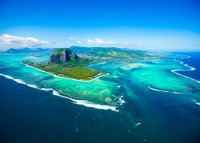The pink pigeon’s continued existence has left some naturalists puzzled. It has been questioned why this bird survived the colonisers’ presence on the island, when the similarly sized Mauritius blue pigeon, with which it shared its habitat, was exterminated.
The answer seems to lie in the pink pigeon’s dietary preferences. Apparently, its favoured food was the fruit of a shrub known as fangame (Stillingis lineata), which has an intoxicating effect. It is said that when fangame berries were in season, the pink pigeons would gorge themselves and flop to the ground in a drug-induced daze. As such, they were an even easier target for hunters. However, the Dutch soon realised that every time they ate a pink pigeon pie, they felt quite dreadful. So the pink pigeons were left alone and are still around today, whilst the last Mauritius blue pigeon (Alectroenas nitidissima) was shot as long ago as 1826.
Birdwatchers visiting Mauritius are in for a treat. Although only nine endemic species still remain, they include some of the world’s rarest birds.
By 1974, the fabulous pink pigeon (Nesoenas mayeri) was down to some 24 individuals. Following intensive captive-breeding efforts by the DWCT and MWF, this gorgeous pigeon (yes, it really is pink!) is now more plentiful, numbering some 400 birds. A substantial population is held in various captive-breeding centres and large numbers of captive-bred birds have been reintroduced into the wild. Successful predator-control programmes, carried out in woodland where wild pink pigeons nest, help tremendously. What was once the world’s rarest pigeon can now be seen in its natural habitat at Black River Gorges National Park and Ile aux Aigrettes.
Another rarity which the DWCT and MWF have saved from certain extinction is the sole-surviving Mauritian raptor, the Mauritius kestrel (Falco punctatus). In 1973, when only four individuals could be found, it was declared the world’s rarest bird. Causes for its dramatic decline included the extensive use of DDT, which was sprayed everywhere except for the Black River Gorges.
Captive breeding of the Mauritius kestrel started in very basic and primitive conditions in 1974 but was hampered by lack of knowledge about the bird. By 1978, the situation had become desperate and so little progress had been made that Carl Jones of the MWF was sent to close down the project. Fortunately his keen interest in hawks and his enthusiasm saw him revive the project and restart the captive breeding, which has led to such spectacular results. Hundreds of kestrels have been bred in captivity and released into the wild; today between 400 and 500 kestrels are estimated to be flying around Mauritius
The phenomenal success which conservationists had with the pink pigeon and Mauritius kestrel meant they could turn their attention to yet another Mauritian endemic in dire straits – the echo parakeet (Psittacula eques). By the 1990s, about 15 birds remained, all in the upland forest of Macchabée ridge. It was regarded as the world’s rarest wild breeding bird. In 2001/02, 21 hand-reared birds were released into the wild and management of wild nests allowed a further 21 birds to fledge naturally. The population now stands at around 600 birds.
For four of the five remaining endemic birds, all passerines (perching birds), things do not look too rosy at present. The Mauritius cuckoo-shrike (Coracina typica), Mauritius bulbul (Hypsipetes olivaceous), Mauritius olive white-eye (Zosterops chloronothus) and Mauritius fody (Foudia rubra) have all suffered heavy losses, caused by introduced predators (rats, mongooses, cats and monkeys) raiding their nests. All are classified as ‘uncommon’ in the definitive field guide Birds of the Indian Ocean Islands (Olivier Langrand and Ian Sinclair, 1998) and are on the International Union for Conservation of Nature red list. At present there is particular concern for the striking Mauritius fody and olive white-eye, both of which have declined to fewer than 150 breeding pairs. In breeding plumage, the male fody is a living jewel, with a ruby-red head and upper breast and dark green underparts. The olive white-eye is equally spectacular, with its olive green back and spectacled eye ring. All of these threatened birds can be seen in the Black River Gorges National Park, their last stronghold. The MWF has released the Mauritius fody and olive white-eye on Ile aux Aigrettes and they have taken to their new home, with nearly 170 and 30 birds respectively now on the island.
Strangely enough, one endemic, the Mauritius grey white-eye (Zosterops mauritanus, locally known as zozo maniok or pic pic), has adapted very successfully to man’s encroachment of its habitat. It is very common all over the island, entering hotel gardens freely, as its near relative on Réunion does there.
The Mascarene swiftlet (Collocalia francica) and Mascarene paradise flycatcher (Terpsiphone bourbonnensis) are shared with Réunion, where both are more plentiful than on Mauritius. Also shared with Réunion (and with Madagascar) is the larger Mascarene martin (Phedina borbonica).
Finally, of great interest to visiting birders is the Round Island petrel (Pterodroma arminjoniana). Amazingly, it is found only around Round Island (where it nests) and on the other side of the globe, around Trindade Island, Brazil. Some authorities previously considered it a full species (separate from the birds of Trindade). However, recent work has shown it is a hybrid of several gadfly petrels; research by the MWF is ongoing. It is endangered but, thanks to all the rehabilitation work that has been conducted on Round Island, its chances for survival have been improved significantly.














